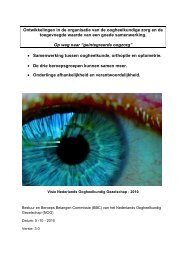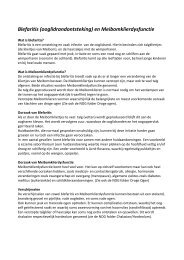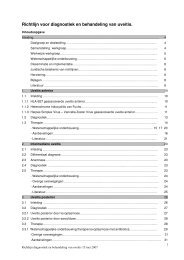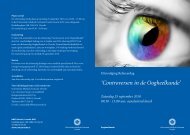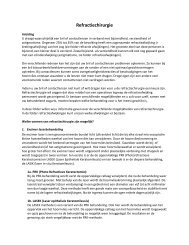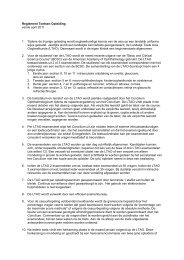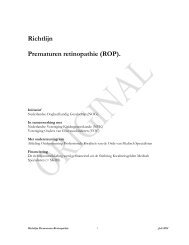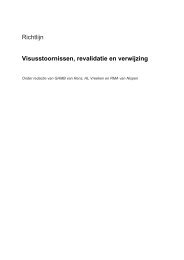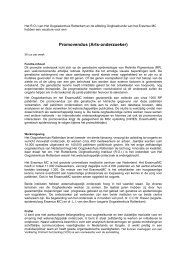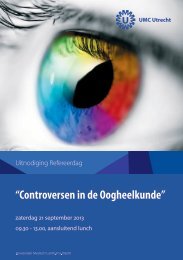terminology and guidelines for glaucoma ii - Kwaliteitskoepel
terminology and guidelines for glaucoma ii - Kwaliteitskoepel
terminology and guidelines for glaucoma ii - Kwaliteitskoepel
You also want an ePaper? Increase the reach of your titles
YUMPU automatically turns print PDFs into web optimized ePapers that Google loves.
2.4 - PRIMARY ANGLE-CLOSURE<br />
Primary angle-closure is appositional or synechial closure of the anterior chamber angle due to a number of possible<br />
mechanisms. This may result in raised IOP <strong>and</strong> may cause structural changes in the eye.<br />
The principal argument to strictly separate primary angle-closure <strong>glaucoma</strong> from primary open-angle <strong>glaucoma</strong> is<br />
the initial therapeutic approach (i.e. iridotomy or iridectomy) <strong>and</strong> the possible late complications (synechial closure<br />
of chamber angle) or the complications resulting when this type of <strong>glaucoma</strong> undergoes filtering surgery (uveal effusion,<br />
malignant <strong>glaucoma</strong>) 7,8 .<br />
Angle-closure <strong>glaucoma</strong>s are clinically divided into the acute <strong>and</strong> chronic <strong>for</strong>ms. The pathogenesis is however multifold<br />
<strong>and</strong> varies according to the underlying condition. By definition, in acute angle-closure, the chamber angle is closed<br />
by iridocorneal apposition that can be reversed, whereas in chronic angle-closure, the angle-closure is irreversible<br />
due to peripheral anterior synechiae.<br />
PROVOCATIVE TESTS<br />
In general provocative tests <strong>for</strong> angle-closure provide little additional in<strong>for</strong>mation since even when<br />
negative they may not rule out the potential <strong>for</strong> angle-closure. In addition they may be hazardous, triggering<br />
an acute angle-closure attack even while the patient is monitored.<br />
2.4.1 - PRIMARY ANGLE-CLOSURE (PAC)<br />
Angle-closure is defined on the basis of findings at gonioscopy<br />
Mechanisms of primary angle-closure 9,10<br />
It is always important to exclude secondary causes of narrow or closed-angles such as a phakomorphic or inflammatory<br />
mechanism. In isometropic eyes this can be helped by comparing axial anterior chamber depths. A-scan or<br />
UBM may be helpful in defining the anatomical relationships <strong>and</strong> measure axial length, AC depth <strong>and</strong> lens thickness<br />
or PC configuration. In primary angle-closure these will be the same in each eye.<br />
a) Pupillary block mechanism<br />
A component of pupillary block accounts <strong>for</strong> most cases of acute, intermittent <strong>and</strong> chronic primary angle-closure.<br />
In pupillary block, the flow of aqueous from the posterior chamber through the pupil to the anterior chamber is<br />
impeded causing the pressure in the posterior chamber to become higher than the pressure in the anterior chamber.<br />
As a result, the peripheral iris, which is thinner than the central iris, bows <strong>for</strong>ward <strong>and</strong> comes into contact with the<br />
trabecular meshwork <strong>and</strong> Schwalbe’s line.<br />
This circular obstruction of the trabecular outflow leads to a rise of IOP up to levels of 50-80 mm Hg; when this<br />
occurs within a few hours, it causes the symptoms <strong>and</strong> signs of acute angle-closure(AAC).<br />
The increased resistance to transpupillary aqueous flow is caused by apposition of the posterior surface of the iris to<br />
the anterior surface of the lens.<br />
The pupillary block mechanism may be precipitated during mid-dilation of the pupil or in conditions where the constrictor<br />
<strong>and</strong> dilator muscles of the pupil are acting together, physiologically as in reading in poor light or pharmacologically,<br />
such as with miotic therapy <strong>and</strong> concomitant dilator muscle stimulation by phenylephrine (the Mapstone provocation<br />
test) 5 . In most cases, the predisposition to pupil block is created by a narrow anterior segment <strong>and</strong> the agerelated<br />
increase of lens volume (see Ch. 2.5.1 <strong>and</strong> 2.5.3).<br />
The prevalence of PAC is higher in hyperopia, in elderly patients, in diabetics, women <strong>and</strong> in some races (especially<br />
Sino-Mongolians) 8,9 .<br />
Ch. 2 - 13 EGS



